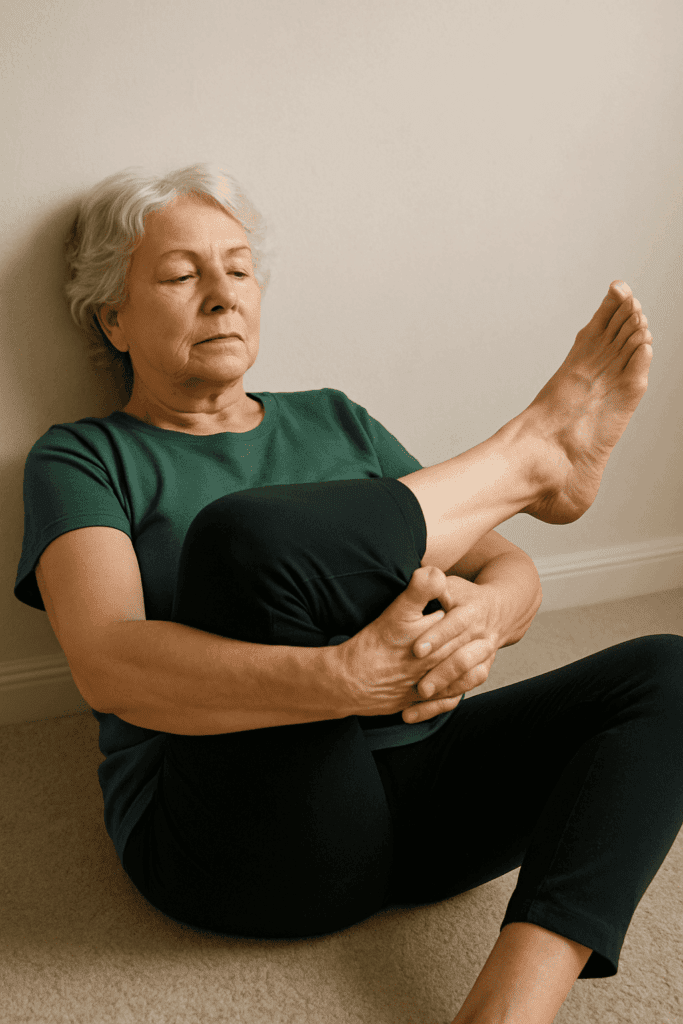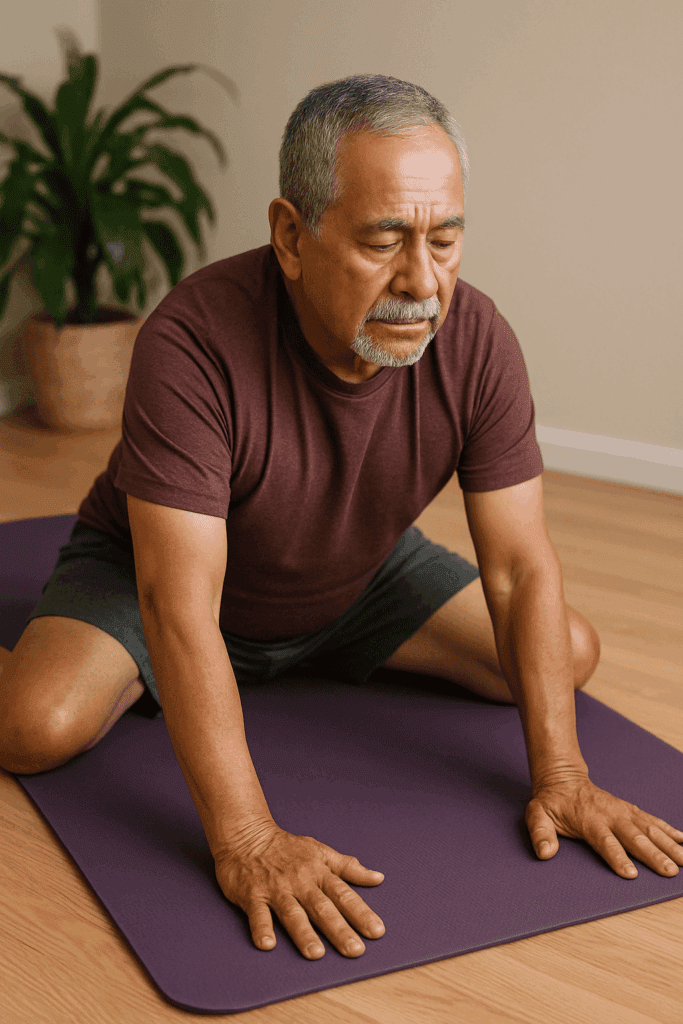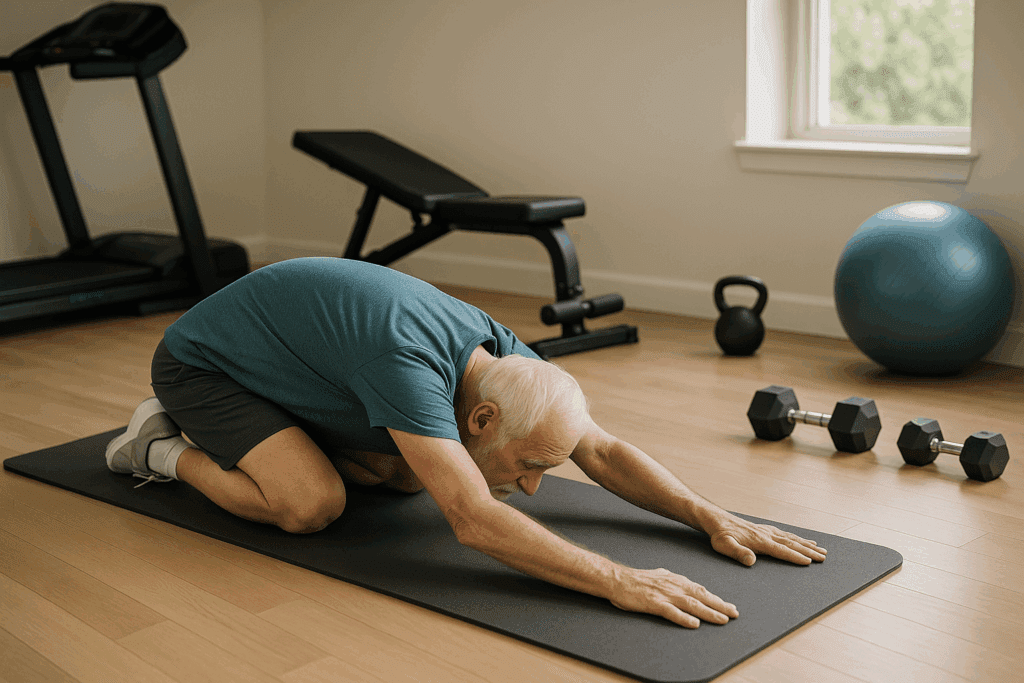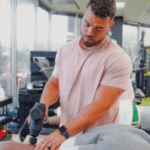Aging naturally brings changes to your posture, flexibility, and muscle balance. Over time, tight hips, weak glutes, and stiff hamstrings can shift the pressure to your lower back. Stretching the right muscles consistently and gently can realign the body’s natural movement patterns and take stress off the spine. “People are surprised how much relief they feel once the surrounding areas start to move better,” says Bickert. “We’re not just targeting pain. We’re improving how the whole body moves.”


Six Stretching Moves That Make a Difference
These exercises are designed with older adults in mind. They’re gentle, supported, and proven to help relieve the muscle imbalances that contribute to lower back strain.
- Lateral Hamstring Stretch
Sit on the floor or a bed with one leg extended out to the side. Hinge gently forward over the leg, keeping your back long. You’ll feel this stretch along the outer part of the hamstring. This muscle often causes pelvic imbalance and tension through the spine.
2. Supported Child’s Pose
Using a stack of pillows or the edge of a chair, rest your arms and upper body forward in a kneeling or seated position. This modified pose gently decompresses the lower spine while staying easy on the knees and shoulders.
3. Figure-4 Piriformis Stretch
Cross one ankle over the opposite knee while seated or lying down. If seated, lean forward slightly. If lying down, draw the leg gently toward your chest. This stretch targets deep glute muscles that often mimic sciatic pain.
4. Modified Kneeling Hip Flexor Stretch
From a half-kneeling position, press your hips forward slightly while keeping your chest lifted. Use a wall or chair for support. Tight hip flexors can pull on the spine and are a common cause of lower back tension.
5. QL Side Stretch
Standing or sitting tall, lift one arm overhead and lean gently to the opposite side. This stretch targets the Quadratus Lumborum, a deep back muscle that is often tight in those who sit frequently.
6. Frogger Stretch
Kneel with knees wide and feet pointing out. Gently push your hips back while resting your forearms or hands on the floor or a cushion. This stretch opens up the inner thighs and hips, which can impact lower back alignment.
How to Begin Safely (Even If You Haven’t Stretched in Years)
“This stiffness didn’t appear overnight,” says Bickert, “but the body responds quickly when treated with care.”
For those just getting started, his advice is to go slowly and stay consistent. Here’s how he recommends easing in:
Begin with three to five deep belly breaths to calm the nervous system and prepare your body.
Use a foam roller, massage tool, or compression wrap to help tight areas loosen before stretching.
Choose supported positions like lying down or sitting against a wall to prevent strain.
Start with just three stretches per day. Keep it short and doable.
Celebrate small progress like being able to bend further or hold a stretch longer.
Stay hydrated and finish with gentle movement like a short walk or light core work.

Common Stretching Mistakes to Avoid
Sometimes it’s not what you do, but how you do it that makes all the difference. Corey Bickert often sees three major mistakes when seniors try to stretch away back pain:
Stretching only where it hurts
“People often bend and twist the lower back because that’s where the pain is,” says Bickert. “But tight hips, hamstrings, and glutes are usually the real issue.”
Pushing too deep too fast
Going too far into a stretch can make your muscles tense up instead of relax. Move slowly and stay within a comfortable range.
Ignoring other areas of the body
“Back pain rarely starts in the back alone,” says Bickert. “If you don’t address the hips, spine, pelvis, and core together, the back will stay overloaded.”
Is Stretching Enough on Its Own?
“Stretching is a powerful start, but not the full solution,” says Bickert. “You also need core strength, glute activation, and better posture habits.” Years of poor movement can wear down your back. That’s why long-term relief often comes from combining stretching with gentle strength training, regular walking, and a few mobility drills to help you move more efficiently. But don’t let that overwhelm you. Even five minutes of stretching each day can make a meaningful difference.
“Grab a yoga mat or a chair, play some soft music, and take five minutes today,” says Bickert. “Your back and your future self will thank you.”

ZestYears Contributor Corey Bickert, CPT




